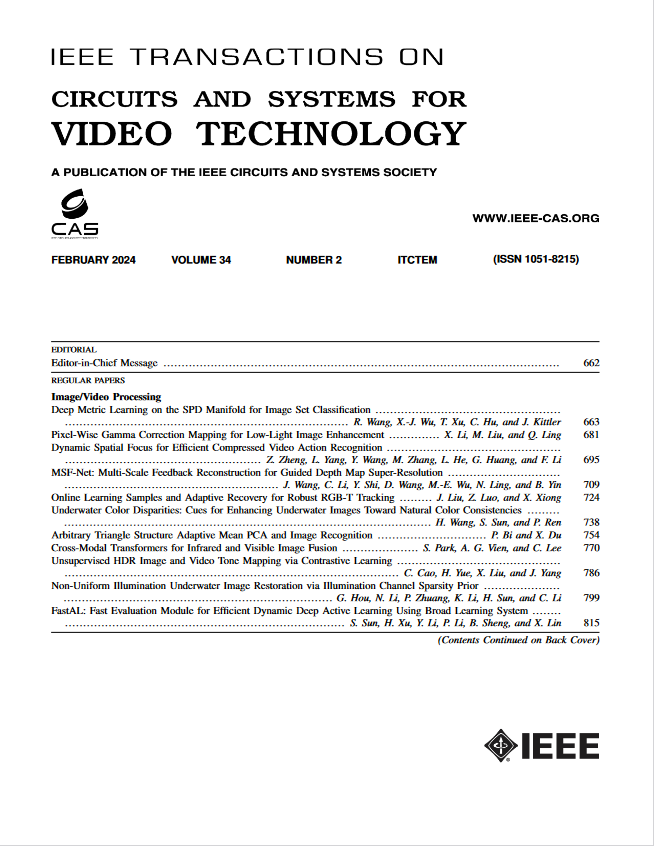自动、鲁棒性和盲视频水印,可抵御摄像头拍摄
IF 8.3
1区 工程技术
Q1 ENGINEERING, ELECTRICAL & ELECTRONIC
IEEE Transactions on Circuits and Systems for Video Technology
Pub Date : 2024-08-23
DOI:10.1109/TCSVT.2024.3448502
引用次数: 0
摘要
视频录制作为一种二次生成方法,会对视频中的水印造成不可逆的破坏,这一直是视频取证中的难题。尽管文献中报道了许多视频水印方法,但这些方法仍然不能很好地抵抗摄像机记录。这促使作者提出了一种新的视频水印方法来抵抗摄像机的记录。该方法在选定的频域系数中嵌入版权水印和同步水印。采用同步水印来保证在解码器侧能够成功提取版权水印。为了在不需要人工辅助的情况下提取版权水印,采用了一种基于神经网络的分割模型来识别摄像机录制视频中带有水印的视频播放区域。同时,对带水印的视频播放区域进行自动透视校正,以准确提取水印信息。实验表明,该方法可以成功地将水印数据嵌入到原始视频中,并能准确地从摄像机录制的视频中提取水印数据。在不同场景下,所提方法的鲁棒性显著优于相关研究,验证了所提方法的优越性和适用性。本文章由计算机程序翻译,如有差异,请以英文原文为准。
Automatic, Robust, and Blind Video Watermarking Resisting Camera Recording
As a secondary generation method, video recording will cause irreversible damage to the watermark within the video, which has always been challenging in video forensics. Although many video watermarking methods are reported in the literature, these methods, however, still cannot well resist camera recording. This has motivated the authors in this paper to introduce a new video watermarking method to resist camera recording. For the proposed method, two watermarks, i.e., copyright watermark and synchronization watermark, are embedded into the well-selected frequency domain coefficients. The synchronization watermark is used to ensure that the copyright watermark can be successfully extracted at the decoder side. To extract the copyright watermark without manual assistance, a neural network based segmentation model is applied to identify the watermarked video-playing region in the camera-recorded video. Meanwhile, automatic perspective correction is performed on the watermarked video-playing region so that the watermark information can be extracted accurately. The experiments show that the watermark data can be embedded into the raw video successfully and extracted from the camera-recorded video accurately by applying the proposed method. And, the proposed method significantly outperforms related works in terms of robustness in different scenarios, which has verified the superiority and applicability of the proposed method.
求助全文
通过发布文献求助,成功后即可免费获取论文全文。
去求助
来源期刊
CiteScore
13.80
自引率
27.40%
发文量
660
审稿时长
5 months
期刊介绍:
The IEEE Transactions on Circuits and Systems for Video Technology (TCSVT) is dedicated to covering all aspects of video technologies from a circuits and systems perspective. We encourage submissions of general, theoretical, and application-oriented papers related to image and video acquisition, representation, presentation, and display. Additionally, we welcome contributions in areas such as processing, filtering, and transforms; analysis and synthesis; learning and understanding; compression, transmission, communication, and networking; as well as storage, retrieval, indexing, and search. Furthermore, papers focusing on hardware and software design and implementation are highly valued. Join us in advancing the field of video technology through innovative research and insights.

 求助内容:
求助内容: 应助结果提醒方式:
应助结果提醒方式:


